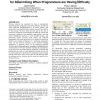Free Online Productivity Tools
i2Speak
i2Symbol
i2OCR
iTex2Img
iWeb2Print
iWeb2Shot
i2Type
iPdf2Split
iPdf2Merge
i2Bopomofo
i2Arabic
i2Style
i2Image
i2PDF
iLatex2Rtf
Sci2ools
GROUP
2010
ACM
2010
ACM
Design, implementation, and evaluation of an approach for determining when programmers are having difficulty
Previous research has motivated the idea of automatically determining when programmers are having difficulty, provided an initial algorithm (unimplemented in an actual system), and performed a small student-based evaluation to justify the viability of this concept. We have taken the next step in this line of research by designing and developing two-different systems that incorporate variations of the algorithm, implementing a tool that allows independent observers to code recorded sessions, and performing studies involving both student and industrial programmers. Our work shows that (a) it is possible to develop an efficient and reusable architecture for predicting programmer status, (b) the previous technique can be improved through aggregation of predicted status, (c) the improved technique correlates more with programmers' perception of whether they are stuck than that of observers manually watching the programmers, (d) the observers are quicker than the developers to conclude...
Applied Computing | GROUP 2010 | Programmers | Small Student-based Evaluation | Terms Human Factors |
| Added | 11 Feb 2011 |
| Updated | 11 Feb 2011 |
| Type | Journal |
| Year | 2010 |
| Where | GROUP |
| Authors | Jason Carter, Prasun Dewan |
Comments (0)

